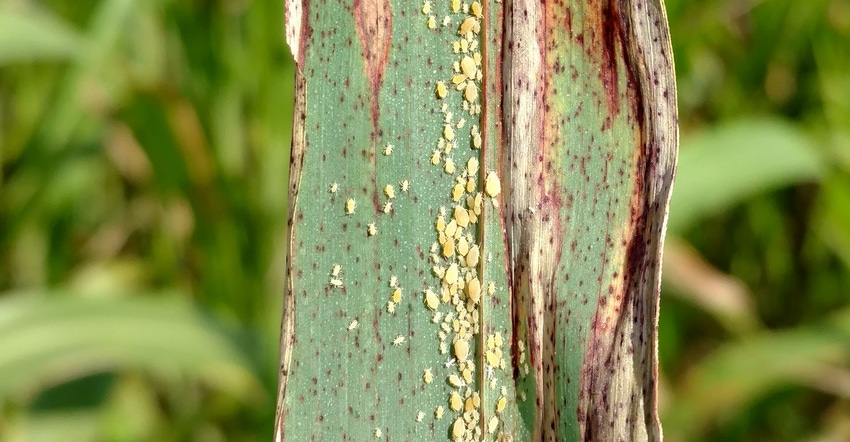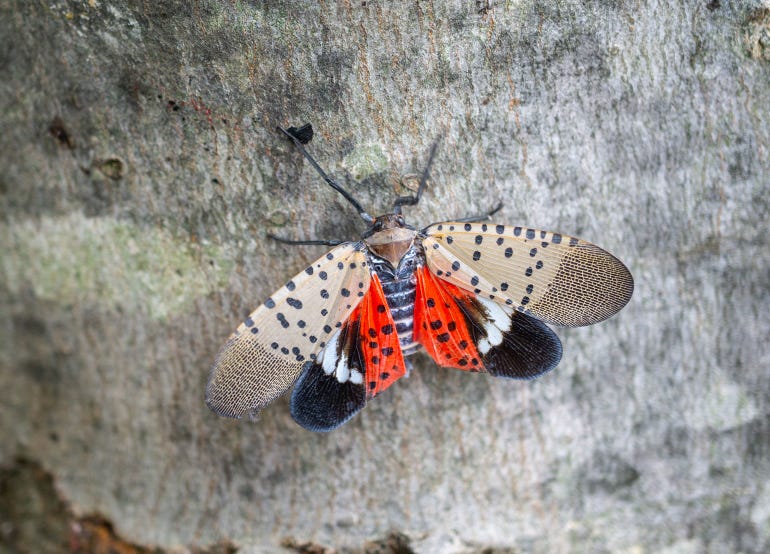March 11, 2020

Scouting for pests is not just confined to in and around row crops. Farmers in the heart of hay country need to be vigilant for insects invading pastures and reducing hay yield.
There are four pests livestock producers and hay growers should pay attention to this year — sugarcane aphids, bermudagrass stem maggots, brown marmorated stinkbugs and spotted lanternfly.
Not so sweet
Tim Schnakenberg, University of Missouri Extension agronomist, noticed a growing population of sugarcane aphids in southwest Missouri starting in 2016. The pests appeared in late-season sudangrass and other forage sorghum stands, specifically around Stone and Christian counties in southwestern Missouri.
"Aphid populations would be so intense that late-season harvests of forage sorghum fields — and in some cases, johnsongrass — would be severely reduced or destroyed," Schnakenberg says.
Infestation can be spotty and happen quickly, so scout all fields. "Agricultural insect pests seem to develop when we least expect them," Schnakenberg says.
New pests with the potential to damage pastures and reduce hay yield include sugarcane aphids, which moved in from Southern states. Masses of the yellow aphids gather on the stems and leaves of individual plants to feed. This leads to yellowing or reddening of the leaves and reduced yield, Schnakenberg says.
Traditional insecticides do not offer effective control, he says. "So far, Transform WG and Sivanto 200SL are the only products that seem to work, though others may soon follow," Schnakenberg says. "Generally, these are legal for grain sorghum. However, always consult the label for special labeling in your state and if it can be used in a forage situation."
The most practical way to deal with sugarcane aphids is to convert acreage to one of the millets that aphids do not affect, he says.
Hidden bug
Another new insect in southwestern Missouri affects bermudagrass. Schnakenberg and Jill Scheidt, field specialist in agronomy, found the bermudagrass stem maggot in Barry County in 2019, but they suspect it may have been present in southwestern Missouri before then. Bermudagrass growers in Gulf states have seen it for several years.
Like sugarcane aphid, the stem maggot affects mid- to late-season growth. It can cause yields to taper off quickly.
The first sign of infestation is when the upper terminal leaves look frost-damaged and die. Looking inside the stem reveals a small white maggot. Infestations vary with different varieties of bermudagrass.
The standard recommendation for control used in the Southern states is to spray with an insecticide seven to 10 days after the previous hay harvest or grazing.
"Fortunately, inexpensive pyrethroid insecticides can be effective on this insect if applied timely," Schnakenberg says. "Unfortunately, most producers do not like to use routine insecticide in bermudagrass stands."

PRETTY PEST: The spotted lanternfly is a beautiful insect. However, it is an emerging pest for alfalfa growers. Infested fields have seen a rise in horse deaths after consumption.

New nemesis
Kevin Rice, MU Extension entomologist, recommends monitoring for another emerging pest that can damage alfalfa.
The brown marmorated stinkbug feeds on alfalfa and many other plants. It has been found in seven Missouri counties so far, including Greene County. Schnakenberg says he has not seen it in southwestern Missouri crops or forages. Unlike the green stinkbug, it moves quickly when established.
Another emerging pest, the spotted lanternfly, could affect vineyards and walnut trees. Found in northeastern states, it lays eggs on metal surfaces, including trains and trucks, giving it a way to spread to Missouri.
The spotted lanternfly is a potential pest for alfalfa, corn and soybeans. It contains cantharidin, a toxin found in blister beetles. It can kill horses when they eat large amounts of infested alfalfa.
For more information, contact the MU Extension agronomy specialist in your area or an entomologist with the Missouri Department of Agriculture.
Source: The University of Missouri Extension, which is solely responsible for the information provided and is wholly owned by the source. Informa Business Media and all its subsidiaries are not responsible for any of the content contained in this information asset.
You May Also Like




